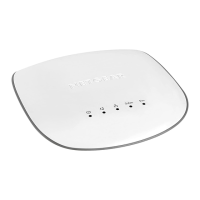(Continued)
DescriptionSetting
You cannot use the default SSID for regular operation (the default SSID is for
setup only). Enter a new name with a maximum of 32 characters.You can use a
combination of alphanumeric and special characters, except for quotation marks
(") and a backslash (\).
SSID
From the menu, select one of the following authentication types for the WiFi
network:
• Open. Authentication is not required and data encryption is not supported.
This setting does not provide any security and is not appropriate for most
situations.
• WPA2-PSK.This option allows only WiFi clients that support WPA2 to connect
to the SSID. Select this option if all WiFi clients are capable of supporting
WPA2.This option uses AES encryption.
• WPA-PSK / WPA2-PSK.This option allows both WPA and WPA2 WiFi clients
to connect to the SSID.This option uses TKIP and AES encryption. Broadcast
packets use TKIP. For unicast (that is, point-to-point) transmissions, WPA
clients use TKIP and WPA2 clients use AES.
For information about setting up WPA2 Enterprise security, see
Set Up an Open or Secure WiFi Network on page 30.
Note
Authentication Type
Unless you select Open from the Authentication Type menu, enter a new
passphrase (network key or WiFi password) for the WiFi network.
Passphrase
6. Click the Apply button.
Your settings are saved.
If you changed the default country, the access point restarts.
Do not close the page!Note
After a short period, the Dashboard page displays automatically. If the Dashboard page does not display,
for example, because you assigned a static IP address, see the next step.
You can now customize the access point settings for your network environment.
7. If the Dashboard does not display automatically, do the following:
Install the Access Point in Your Network and Access It for Initial Configuration
23
Insight Managed Smart Cloud Wireless Access Point WAC505 User Manual

